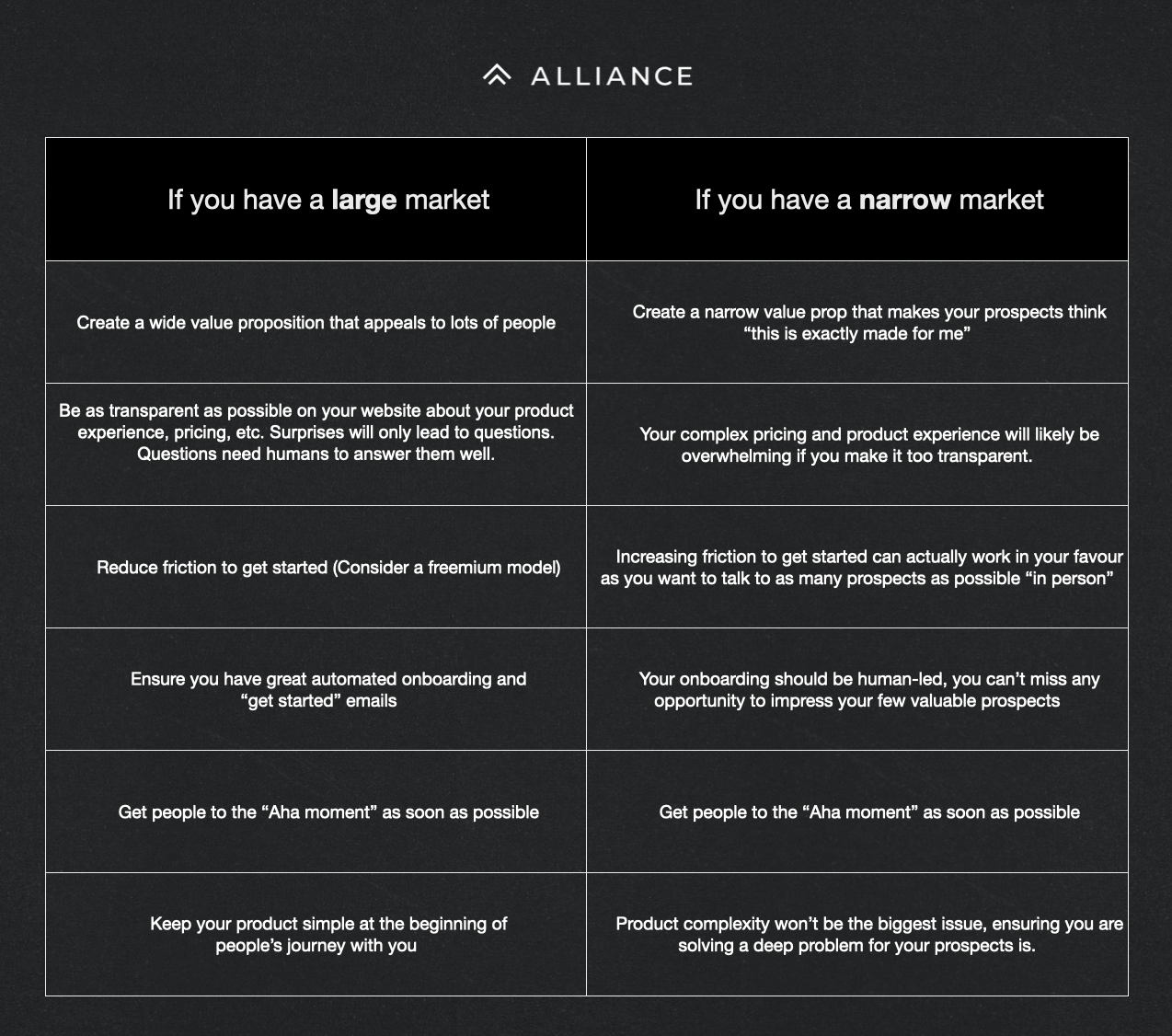Editor’s note: You may remember that recently we announced a partnership with Alliance and the renowned Vlerick Business School for an upcoming interactive masterclass designed specifically for marketing and growth teams working at European tech scale-ups. This article, written by Robin Geers, the founder and CEO of Alliance, and edited by tech.eu, is part of this partnership. In a series of stories, Robin is touching upon important topics before the five-week intensive masterclass begins. All credits for the practical insights in this specific post goes to one of the experts from the program: Sançar Sahin (Ex VP Marketing at Hotjar and Typeform).
A Go-To-Market Strategy can sound like a big, scary thing. The reality is that a good go-to-market can be simplified into a one-page document. However, there is a lot of work that needs to be done to be able to feel confident in the strategy you put forward to your C-level team.
Let’s start with understanding what a go-to-market strategy actually is. Your go-to-market is a clear articulation of how you will take your product to your target customers and create a competitive advantage while doing so. It’s a practical tool that helps you make decisions on a day-to-day basis.
It is not something that only the marketing department owns, neither it’s a long document or inspirational presentation. A good go-to-market can be summarised onto one page.
To be able to clearly articulate how you will take your product to your target customers and create a competitive advantage, there are a few steps you will need to take first. Start by asking yourself the following four questions:
- Who are you trying to reach?
- How will those people buy your product?
- Which channels will help you reach your customers?
- How should the product evolve to support all of the above?
Who are you trying to reach?
Having a clear idea of who you are trying to reach has lots of benefits for your marketing team. For example, it’s going to make customer and market research much more focussed. On top of this, there two key ways of knowing who your target market is that will benefit your go-to-market strategy.
- It allows you to quantify the opportunity and measure success.
- It directs you in terms of how you position your product.
For example, an ice cream machine will need to be positioned in very different ways depending on if you’re targeting an ice cream manufacturer vs an end consumer. It’s definitely not a case of one-message-fits all.
So let’s look at the first point, quantifying your market and its value. You can calculate it with the following simple formula:
= Total Addressable Market Value
Once you have this, it’s up to you and your exec team to ask and answer “is this an acceptable market value for what we want to achieve?” If the answer is yes, then great, continue to the next steps of your go-to-market.
If the answer is no, you will need to go back to the beginning and change the criteria for your target market until you find a market that is big enough.
Now you know who you are selling to, the next step is to define how they will buy your product.
How will people buy your product?
Let’s look at two examples:
Airbnb guests visit the website, search for somewhere to stay, and they checkout, without speaking to a real human being. So, they “buy” accommodation on a self-serve basis.
SAP solution buyers — who are likely to be C-level executives — on the other hand, have to request a demo, speak to a salesperson and need to be navigated through a complex purchase cycle.
So how do you know which is right for your product and why does it matter?
Well, it matters because if your product isn’t built with your customers in mind, in terms of how they will buy it, then you’re going to create a lot of unnecessary friction. imagine needing to speak with a salesperson before booking an Airbnb. Or on the other side of the coin, imagine not having a salesperson to hold your hand through the complexities of SAP. It just wouldn’t work.
Where you often see is an executive team with experience in a particular model and there is an immediate assumption that this model is the right one. If the target customer doesn’t like to purchase in that way, it’s very hard to make things work.
To define how people want to buy your product, look at who your target customers are and how many of them you are trying to reach.

If there are 20 million potential customers in your market, a high-touch sales model like SAP is unlikely to be viable as you would need a whole lot of salespeople to be able to talk to them all. In this scenario, you probably want to keep your value proposition nice and wide and offer an easy, frictionless purchase experience on your website.
If you decide on reaching millions of potential customers, it already starts to lay out the path of what needs to be done:
- Create an easy-to-understand message for the website,
- Make the website simple to navigate,
- Offer a freemium or free trial entry point,
- Create clear and simple product onboarding documentation and tutorials,
- …
You can see that by simply articulating who you’re trying to target, and how you expect them to buy, makes certain decisions a lot easier.
The same applies to decide to reach only a few thousand potential customers in your market, it shows a different path of the decisions to make:
- Should we hire a sales team?
- Should we invest in expensive events to meet people face-to-face?
- …
As they are all busy executives, expecting them to self serve and do all the work themselves probably won’t work. With only a few thousand potential people to convince to buy your product, you need to talk to as many of them directly as possible.
So by this point, you know who you are trying to reach and how you expect them to buy. Now you need to articulate in your go-to-market strategy which channels you will use to reach people.
Which channels will help you reach your customers?
Using our examples from before, Airbnb invests significantly in wide-reaching marketing tactics such as digital marketing and even billboard advertising. This works for them because there are millions of potential customers in their market. They cast a wide net because they have a large audience to throw it at. That’s why it’s unlikely you will catch Airbnb targeting specific people on Linkedin.
On the other hand, enterprise-level software companies like SAP or Salesforce need to be much more targeted in their approach. These companies use tactics such as sponsoring events, using account-based-marketing techniques, or even cold-calling individual potential buyers.
You must define the channels that work for you and write them clearly into your go-to-market document. Doing this helps you say no to things, which is an important part of any Marketing leader’s job. Being able to apply a quick check against your GTM strategy can be massively time-saving. Look at the following two examples:
“Hey, shall we give event sponsorship a try this quarter?” - “Nope, because it doesn’t fit out GTM”
“Should we invest in this cool ABM software?” - “Sure, as long as it helps us reach more of our specific list of prospects.”
By this point, if you’ve managed to clearly articulate the first three go-to-market questions, your strategy will be taking shape nicely. This takes us to the fourth question on how the product should evolve to support the first three questions.
How should the product evolve to support all of this?
Developing the go-to-market strategy isn’t just a marketing concern because your ever-evolving product will need to evolve in such a way that it supports your GTM strategy. Either that or your GTM strategy will need to change to support the product development. Either way, the two things can’t work in silos.
For example, let’s imagine that you picked a large target market and therefore you have a wide value proposition and a self-serve purchasing model. If your product becomes more and more complex over time — because of a well-intentioned and enthusiastic product team — you will start to create a delta between the promise you give your potential customers and what you end up delivering.
If I, as a potential buyer, expect an easy-to-understand and easy-to-use product but the reality is that I’m faced with a high degree of complexity, then I will likely want a real human being to hold my hand throughout the process. But, in this case, that human being wouldn’t be there because they weren’t part of the go-to-market strategy.
So why should more than just marketing care about your go-to-market strategy? Because in short, a good go-to-market needs all pieces of the puzzle to fit into place which involves marketing, product, support success, and even the way you do legal, compliance, and pretty much anything across the organisation.
To wrap these four questions up, Sançar was kind enough to share a few of his learnings from working with go-to-markets for a few different companies.
Learning 1:
If you’ve been tasked with coming up with the go-to-market strategy for your company, make sure you know exactly what that means. Spend a good chunk of time aligning with your CEO on her expectations. For example, are you expected to facilitate the articulation of the strategy, or are you expected to come up with it and make the various necessary decisions?
Learning 2:
If you see that the go-to-market strategy is being talked about in the context of a marketing strategy only, then I strongly recommend that you spend some time aligning the team on the fact that a good GTM strategy connects the many dots across various departments. This is why it’s tricky to have your Head of Marketing department own it. It’s better if a Chief Revenue Officer, Chief Strategy Officer, or the CEO owns it.
Learning 3:
Finally, if you find yourself putting your go-to-market into a long, fancy slide deck then you’re probably not doing it right. Again, I’m speaking from experience as I’ve made this mistake. Spend less time on slides and more time on answering the questions and making explicit decisions. A good go-to-market will fit on a one-page Google doc.
Featured image credit: JESHOOTS.COM on Unsplash



Would you like to write the first comment?
Login to post comments